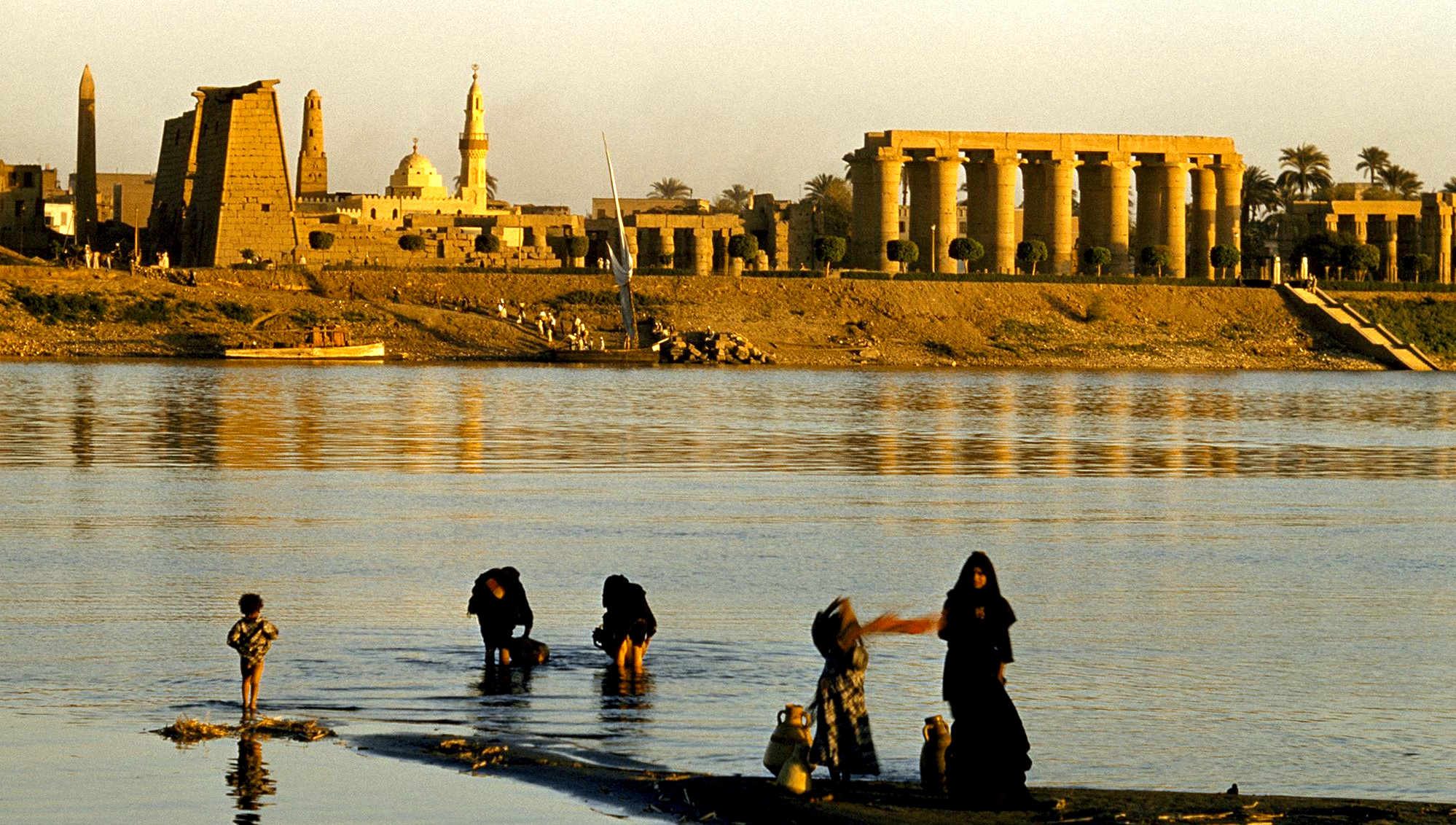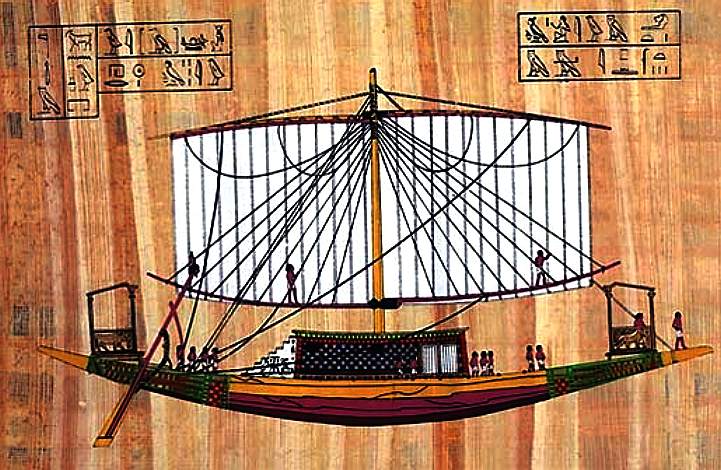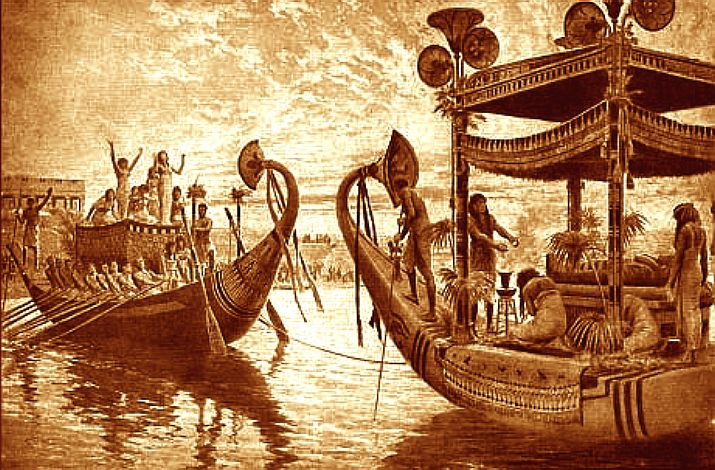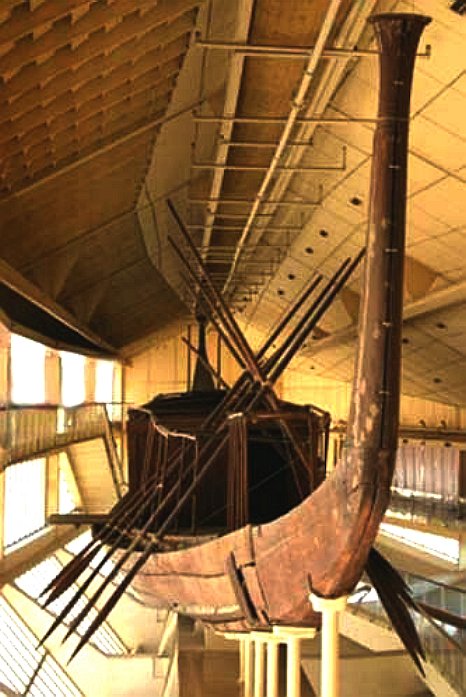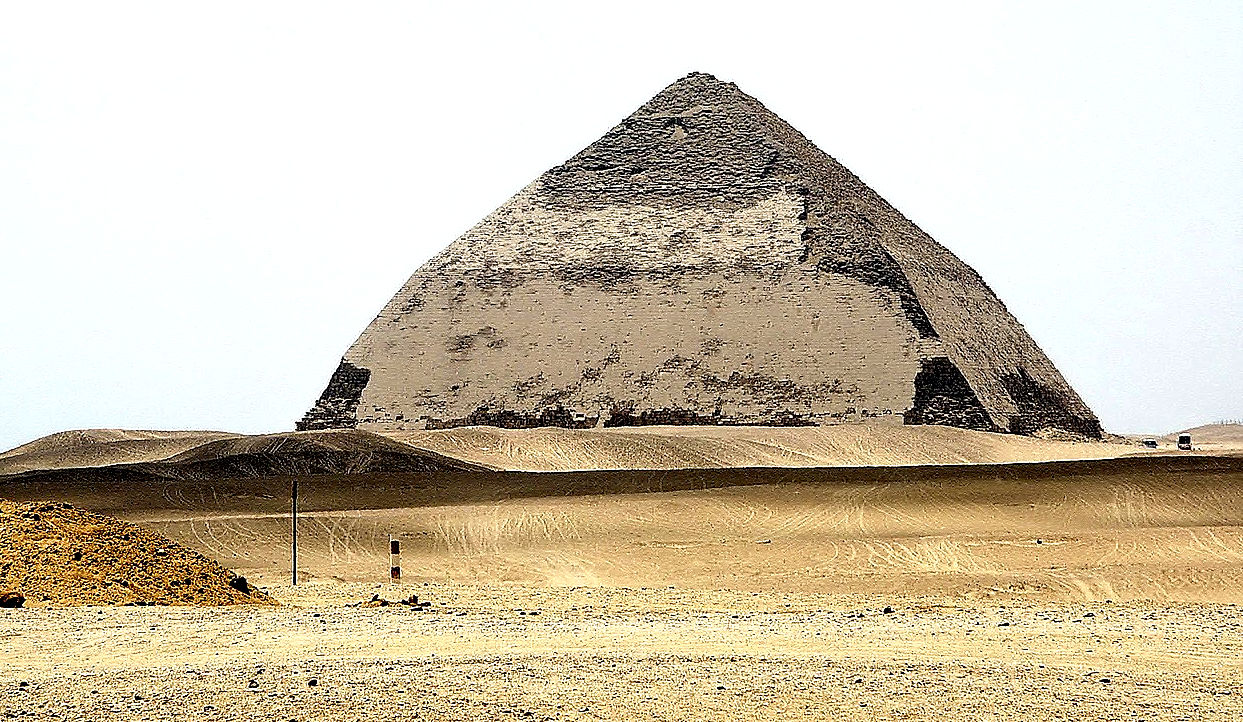
Dahshur
is the site of the Sneferu's Pyramid, the third tallest in
Egypt, though smaller in volume than Sneferu's Red Pyramid. Before
those, Sneferu started to built a step Pyramid
at Meidum that scholars think was unfinished, and the Bent
Pyramid - also at Dashur - before building the Red Pyramid.
This boy got around. Obviously, building rather than
designing his afterlife paradise. A wasteful method. Where a
better approach in terms of use of resources is to plan,
then build. The Pharaoh seems to have changed his mind quite
a bit. Including relocating his monuments.
The Bent Pyramid is an ancient Egyptian
monument located at the royal necropolis of Dahshur, approximately 40 kilometres south of Cairo, built under the Old Kingdom Pharaoh Sneferu (c. 2600 BC). A unique example of early pyramid development in Egypt, this was the second pyramid built by Sneferu.
The Bent Pyramid rises from the desert at a 54-degree inclination, but the top section (above 47 metres) is built at the shallower angle of 43 degrees, lending the pyramid a visibly 'bent' appearance.
Archaeologists now believe that the Bent Pyramid represents a transitional form between step-sided and smooth-sided pyramids. It has been suggested that due to the steepness of the original angle of inclination the structure may have begun to show signs of instability during construction, forcing the builders to adopt a shallower angle to avert the structure's collapse. This theory appears to be borne out by the fact that the adjacent Red Pyramid, built immediately afterwards by the same pharaoh, was constructed at an angle of 43 degrees from its base. This fact also contradicts the theory that at the initial angle the construction would take too long because Sneferu's death was nearing, so the builders changed the angle to complete the construction in time. In 1974, Kurt Mendelssohn suggested the change of the angle to have been made as a security precaution in reaction to a catastrophic collapse of the Meidum Pyramid while it was still under construction. The reason why Sneferu abandoned the Meidum Pyramid and its Step Pyramid may have been a change in ideology. The royal tomb was no longer considered as a staircase to the stars; instead, it was served as a symbol of the solar cult and of the primeval mound from which all life sprang.
It is also unique amongst the approximately ninety pyramids to be found in Egypt, in that its original polished limestone outer casing remains largely intact. British structural engineer Peter James attributes this to larger clearances between the parts of the casing than used in later pyramids; these imperfections would work as expansion joints and prevent the successive destruction of the outer casing by thermal expansion.
The ancient formal name of the Bent Pyramid is generally translated as (The)-Southern-Shining-Pyramid, or Sneferu-(is)-Shining-in-the-South. In July 2019, Egypt decided to open the Bent Pyramid for tourism for the first time since
1965. Tourists are able to reach two 4600-year-old chambers through a 79-metre narrow tunnel built from the northern entrance of the pyramid. The 18-metre-high "side pyramid", which is assumed to have been built for Sneferu's wife Hetepheres will also be accessible. It is the first time this adjacent pyramid has been opened to the public since its excavation in 1956.
INTERNAL PASSAGES
The Bent Pyramid has two entrances, one fairly low down on the north side, to which a substantial wooden stairway has been built for the convenience of tourists. The second entrance is high on the west face of the pyramid. Each entrance leads to a chamber with a high, corbelled roof; the northern entrance leads to a chamber that is below ground level, the western to a chamber built in the body of the pyramid itself. A hole in the roof of the northern chamber (accessed today by a high and rickety ladder 15 m (50 ft) long) leads via a rough connecting passage to the passage from the western entrance.
The western entrance passage is blocked by two stone blocks which were not lowered vertically, as in other pyramids, but slid down 45° ramps to block the passage. One of these was lowered in antiquity and a hole has been cut through it, the other remains propped up by a piece of ancient cedar wood. The connecting passage referenced above enters the passage between the two portcullises.
LANDSCAPING
As the first geometrically "true" pyramid in the world, the Bent Pyramid shows its uniqueness not only from the method of construction but also manifests through the surrounding landscape. Nicole Alexanian and Felix Arnold, two distinguished German archeologists, provided a new insight toward the meaning and function for the Bent Pyramid in their book named The complex of the Bent Pyramid as a landscape design project. They noticed that the sites of the Bent Pyramid sits aside in the middle of a pristine desert area instead of fertile area near the Nile River like all the other pyramids. After a long period detailed investigation, they believed the landscape surrounding the Bent Pyramid is in fact man-made.
When the archaeologists observed the landscape closely, the plateau of the pyramid seemed leveled artificially and nearby escarpment and trenches were all made by human beings. Moreover, there were a few traces left indicating a build-up of garden enclosure. The impact of humans on the landscape is also represented by the presence of a wadi channel connecting the Bent Pyramid to a harbor, which shows a distinct difference between the southern and northern side of the channel. It shows a substantial difference in level with regards to the finding. The slope of southern wadi channel seemed to have been rectified when the archaeologists compared it to the natural and twisted northern side. Arne Ramisch supported this idea by providing evidence that displays a low correlation of fraternal patterns of channel and natural topography in the environs, which is southern side of wadi, of the Bent Pyramid.
The purpose of this man-made construction might hold mythical meaning and ritual function. Based on available evidence, garden enclosure and water basins both are the counterparts of funeral rites which indicates a regular practice of rituals at Dahshur. However, there is also another implication states that the garden closure helping to create satisfactory living environment in the desert. Other than that, the leveled plateau, the quarrying trenches on the western and southern sides of the pyramid, and the nearby smaller tombs cooperate together to emphasize the monumentality of the Bent Pyramid, aiding by its long distance from the surrounding structures. These features represent the imprinting social hierarchy in the creation of this landscape, which furthermore represents the power of Egyptian King at that time. Alexanian and Arnold describes this construction in a concise phrase: an artificial mountain erected within an artificial landscape.
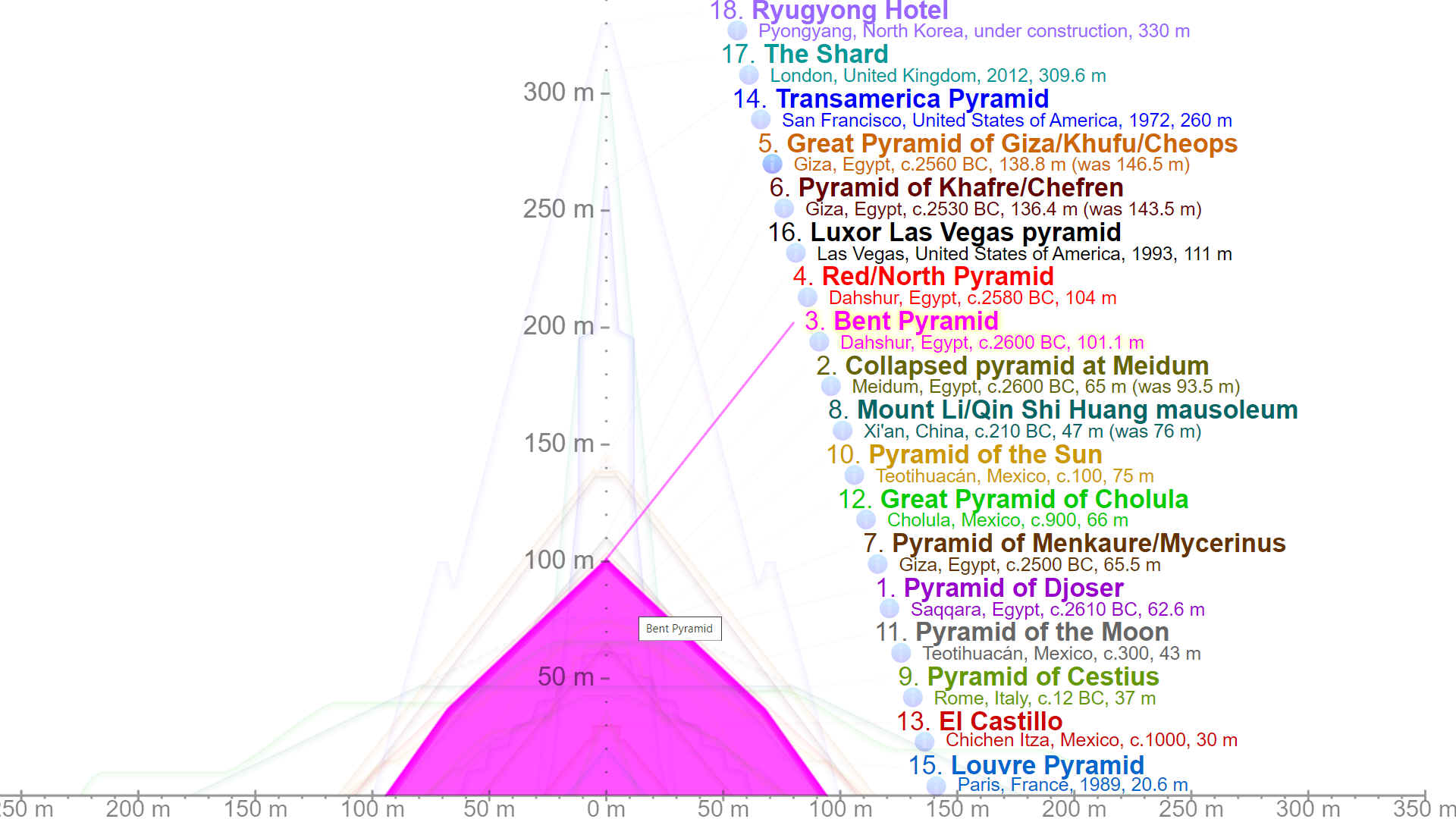
Apart
from ruling their country, the
ancient Egyptians
had time to contemplate how they would cope in the afterlife
during the flooding of the Nile, when farm laborers could be
used to build, giving them a positive agenda. Each
successive ruler of the sandy kingdom, wished for more
comforts, and to outdo their forebears, in terms of how they
would be remembered.
Egypt was one of the richest and most powerful civilizations in the world
at that time. So could afford to convert their national
output, into something tangible, for their citizens to
marvel at. At the time they had few threats to national
security.
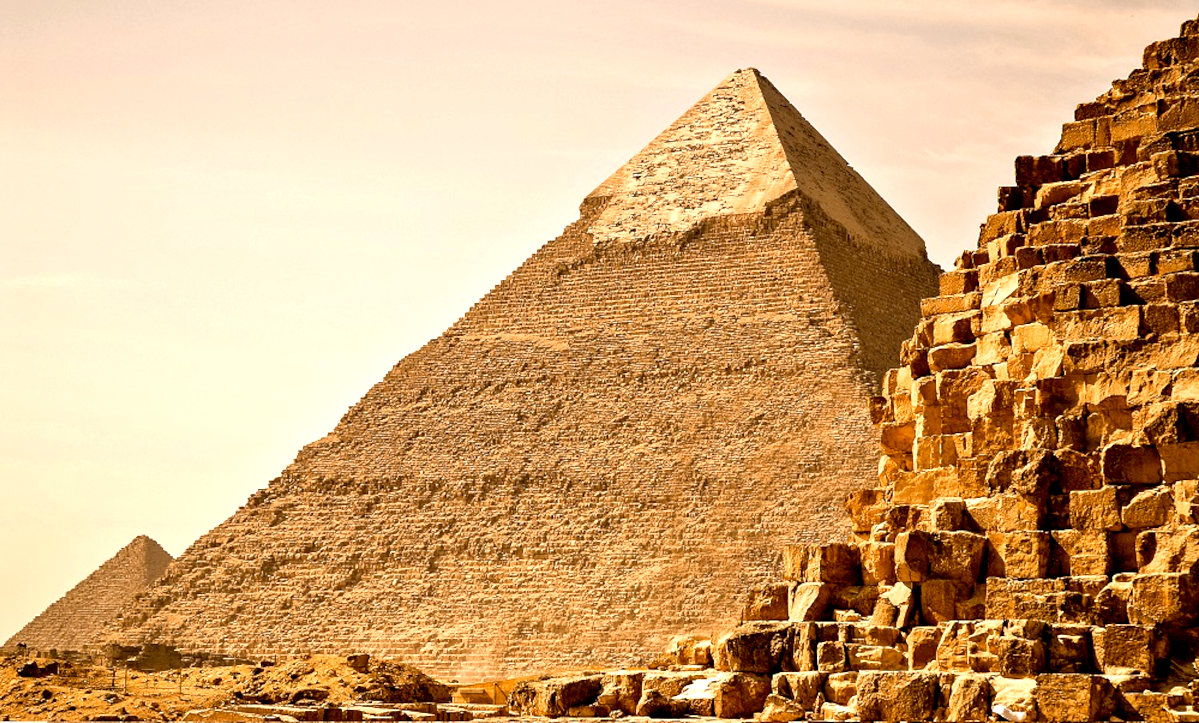
Generally,
the bigger the pyramid, the more important the Pharaoh. It's
a Freudian thing. This compendium is in order of height.
There are many very interesting pyramid designs that will be
covered in the general indexing, if they have unusual or
developmental features. Since, the art of pyramid
construction and development appears to have been an ongoing
thing, until it fizzled out as a result of resource scarcities, adventures of thieves, and land grants
to priests, as the last straw that broke the camel’s back.
Pyramids ceased to be economically viable, and a huge drain
on what we'd call the Gross National Product (GNP) today.
And as for climate
change, they are hardly a sustainable practice, in UN
SDG terms.
On
the basis that the
taller the pyramid, the higher the status of the
king or queen,
it might be argued that Khufu takes first prize, with Khafre
a close second. After that, nobody came close to 140 meters,
as the national goal to achieve a taller building than the
last ruler fell by the wayside.
Please
note, this is not a definitive table, but our own guide,
based on freely available information. Students of
archaeology and Egyptologists will draw their own
conclusions. Observations are most welcome, if we have
misquoted anything. We'd be pleased to make corrections as
applicable.

RULER
WITHOUT A PYRAMID - Tragically, queen Cleopatra poisoned herself
with an Egyptian cobra. Later her
mausoleum was washed into the sea by an earthquake and
tsunami in 365AD. Leaving little to visibly remind us of
the great Pharaoh.
The oldest known pyramid in Egypt was built around 2630 B.C. at Saqqara, for the third dynasty’s King Djoser. Known as the Step Pyramid, it began as a traditional mastaba but grew into something much more ambitious. The pyramid’s architect was Imhotep, a priest and healer who some 1,400 years later would be deified as the patron saint of scribes and physicians. Over the course of Djoser’s nearly 20-year reign, pyramid builders assembled six stepped layers of stone (as opposed to mud-brick, like most earlier tombs) that eventually reached a height of 204 feet (62 meters); it was the tallest building of its time. The Step Pyramid was surrounded by a complex of courtyards, temples and shrines where Djoser could enjoy his afterlife.
After Djoser, the stepped pyramid became the norm for royal burials, although none of those planned by his dynastic successors were completed (probably due to their relatively short reigns). The earliest tomb constructed as a “true” (smooth-sided, not stepped) pyramid was the Red Pyramid at Dahshur, one of three burial structures built for the first king of the fourth dynasty, Sneferu (2613-2589 B.C.) It was named for the color of the limestone blocks used to construct the pyramid’s core.
